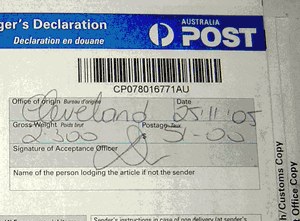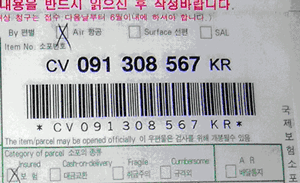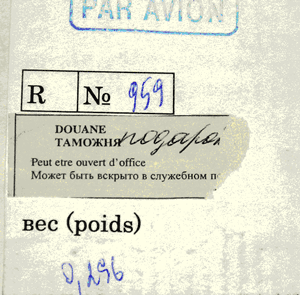|
This field information kit is designed to help reinforce
how important it is for Postal ServiceTM employees to properly scan all inbound international parcels at delivery. As of
January 1, 2006, the Postal Service began assuming liability for the loss, damage, or rifling of all parcel items sent to
the United States from a foreign destination. Properly scanning all inbound international parcels at delivery helps provide customers with the service they expect and at the
same time minimize the liability of the Postal Service. The
Postal Service implemented this change to comply with a
new requirement established by the Universal Postal Union
(UPU).
The information in this kit helps to reinforce the procedures for properly scanning all inbound international parcels at delivery. This kit contains the following materials:
• Briefing Article.
• Sample Labels.
• Frequently Asked Questions.
• Service Talk for Retail and Delivery Employees.
Briefing Article
Scanning Inbound International Parcels
On January 1, 2006, the Postal Service assumed liability
for the loss, damage, or rifling of all parcel items sent to the
United States from a foreign destination. The Postal Service implemented this change to comply with a new requirement established by the UPU. According to the UPU
decision, liability applies to all items defined as a parcel,
whether or not the item includes a special service. Coverage is limited to the actual value of the contents or the maximum indemnity based on the weight of the article,
whichever is less.
In an effort to provide our customers with the service
they expect and at the same time minimize the liability of
the Postal Service, postmasters and managers should
instruct delivery and other field employees of the importance of scanning all inbound international parcels. To assist postmasters and managers in talking with their delivery
and field personnel, the following information details the
process for properly identifying and scanning inbound international parcels at delivery.
Scanning and Signature-Capture Process
When an employee scans or enters an inbound international parcel at the point of delivery, the Mobile Data
Collection Device (MDCD) scanner either recognizes the
barcode or label ID that was entered or provides a prompt
to the employee asking if the mailpiece is one of the
following:
1. International.
2. COD.
3. Neither.
If the employee enters "3" for "Neither" - which is an incorrect procedure - the scan will not be accepted. When
the employee enters "1" for "International" - which is the
correct procedure - the scan will be accepted. If the employee then chooses "Delivered" as the Confirmation
Event, the scanner activates additional prompts that guide
the employee in completing the necessary signature-capture process. Employees must follow the signature-capture
requirements for inbound express, registered, recorded delivery, and insured mail items received from foreign
countries.
All inbound international parcels and express, registered, recorded delivery, and insured mail items that require
scanning and signature capture at delivery contain either of
the following designations:
• A barcode that starts with a specific alpha
character - either C, R, A, V, or E.
• A manual endorsement that starts with a specific
alpha character - either C, R, A, V, or E.
It is suggested that employees always look for these
designations on inbound international parcels to help ensure they perform the required scanning and signature-
capture process.
Label Designations
Listed below are the different types of inbound international items that require either a scan of the barcode or a
keyed entry of the label ID at the time of delivery. Also
noted are the different types of designations that appear on
each inbound international parcel label.
• Parcels have a "C" prefix, such as "CP123456789BK."
• Insured parcels may have a barcode or some other
stamped or handwritten number that starts with a "V"
prefix, such as "V123456789KY" or "VV123456789KY."
Most insured parcels also have a "C"-prefix barcoded
label. If a parcel contains two codes, employees are to
scan both barcodes at the time of delivery.
• Express mail items have a barcode or some other
stamped or handwritten number that starts with an
"E" prefix, such as "EP006533895IT."
• Registered mail items may have a barcode or some
other stamped or handwritten number that starts with
an "R" prefix, such as "R123456789IL" or
"RR123456789IL."
• Recorded delivery items may have a barcode or
some other stamped or handwritten number that
starts with an "A" prefix, such as "A123" or "AA123."
Parcels With Multiple Barcodes
For any inbound international parcel that bears more
than one barcode, the employee must scan all of the barcodes at the time of delivery. If a barcode is unreadable, the
employee must enter the label's letters and numbers. Some
possible multiple barcode combinations are noted below:
• Parcel "C" and insured "V."
• Express mail "E" and customs form "C."
Scanner Malfunction or Scanner Unavailable
If a scanner isn't available at the time of delivery or if
there is a scanner malfunction, the delivery employee must
record each label's letters and numbers, the mailer's name,
and the date, time, and ZIP CodeTM of delivery on the front
of PS Form 3849, Delivery Notice/Reminder/Receipt, obtain the recipient's signature, and deliver the item. When a
working scanner becomes available, follow standard procedures for Manual Input (Option 5) (i.e., enter the information
from the front of PS Form 3849) and then process the PS
Form 3849 following the signature-capture process.
Sample Labels
The appearance of the labels on inbound international
parcels can differ greatly based on the country of origin. To
assist employees in properly identifying inbound international mail that requires scanning and signature capture,
the following sample labels are provided as examples of
what to look for.





|
Frequently Asked Questions
1. The look of the labels on inbound international parcels can differ greatly based on the country of origin,
so how will I know when I need to scan an item?
All inbound international parcels require either a scan
or a manual entry at delivery based on which one of
the following indicators appears on the item:
• A barcode that starts with a specific alpha
character - either C, R, A, V, or E.
• A manual endorsement that starts with a specific
alpha character - either C, R, A, V, or E.
You should always look for these designations on inbound international parcels to help ensure you perform the required scanning and signature-capture
process.
2. What indicators or markings should I look for on inbound international parcels?
Inbound international parcels display a unique number that begins with the alpha character of either C,
R, A, V, or E. The alpha character represents the following types of inbound international mail:
• C - parcel (e.g., "CP123456789BK").
• R - registered mail (e.g., "R123456789L" or
"RR123456789L").
• A - recorded delivery (e.g., "A123" or "AA123").
• V - insured parcel (e.g., "V123456789KY" or
"VV123456789KY").
• E - express mail (e.g., "EP006533895IT").
3. Is it possible for an inbound international parcel to
contain more than one barcode?
Yes, an inbound international parcel could contain
more than one barcode. Here are some possible multiple barcode combinations you might see:
• Parcel "C" and insured "V."
• Express mail "E" and customs form "C."
4. Which barcode do I scan when an inbound international parcel contains more than one barcode?
For any inbound international parcel that bears more
than one barcode, you must scan all of the barcodes
at the time of delivery. If a barcode is unreadable, you
must enter the barcode's letters and numbers into the
scanner.
5. What should I do when a label won't scan after I've
tried to scan it several times and I can't input the
number?
Write each label's letters and numbers, the mailer's
name, and the date, time, and ZIP Code of delivery
on the front of PS Form 3849, obtain the recipient's
signature, and deliver the item. Upon returning to the
office, try entering the article's letters and numbers
into a different handheld MDCD scanner in Manual
Input (Option 5) mode. Notify your supervisor if you
are unable to enter this information into a scanner.
6. What should I do if my scanner fails to work while I'm
out on my route?
Record all information on PS Form 3849 for Manual
Input as needed for each delivery. Record all information on the parcel for attempted deliveries. Upon return to your unit, notify your supervisor of the scanner
malfunction to have it replaced. When a working
scanner becomes available, follow standard procedures for Manual Input (Option 5) (i.e., enter the information from the front of PS Form 3849) and then
process the PS Form 3849 following the signature-
capture process.
7. How can I check that a parcel scan was actually entered into my handheld scanner?
Go to MAIN OPTIONS and choose number 2,
REVIEW ENTRIES, and follow the prompts. You will
see a list of all items scanned. If the item you were
unsure of does not appear on the list, choose
ESCAPE. Go back to MAIN OPTIONS and select
number 1, SCAN BAR CODES. Rescan the item.
Service Talk for Retail and Delivery Employees
Scanning Inbound International Parcels at Delivery
It is essential that each of us understands the importance of properly scanning inbound international parcels at
delivery. This is critical because as of January 1, 2006, the
Postal Service began assuming liability for the loss, damage, or rifling of all parcel items sent to the United States
from a foreign destination. This new policy was implemented to comply with a requirement established by the UPU.
Another very important reason for proper scanning is
our customers. We need to provide them with the service
they expect and deserve.
The proper scanning of all inbound international parcels
takes commitment from each one of us. So here's what you
need to know:
• When you scan or enter an inbound international parcel at the point of delivery, the MDCD scanner either
recognizes the barcode or label ID that was entered
or provides a prompt to you asking if the mailpiece is
one of the following:
1. International.
2. COD.
3. Neither.
• If you enter "3" for "Neither" - which is an incorrect
procedure - the scan will not be accepted.
• When you enter "1" for "International" - which is the
correct procedure - the scan will be accepted.
• If you then choose "Delivered" as the Confirmation
Event, the scanner activates additional prompts that
guide you in completing the necessary signature-
capture process.
• You must follow the signature-capture requirements
for inbound express, registered, recorded delivery,
and insured mail items received from foreign
countries.
All inbound international parcels and express, registered, recorded delivery, and insured mail items that require
scanning and signature capture at delivery contain either of
the following designations:
• A barcode that starts with a specific alpha
character - either C, R, A, V, or E.
• A manual endorsement that starts with a specific
alpha character - either C, R, A, V, or E.
Always look for the C-R-A-V-E designation on inbound
international parcels to help ensure you perform the required scanning and signature-capture process.
Be aware that you play a role in helping protect the Postal Service from liability for inbound international parcels
that are not properly scanned. And always keep in mind the
needs and expectations of our customers. Then, do your
part - one scan at a time.
— International Marketing,
Product Development, 3-30-06
|

